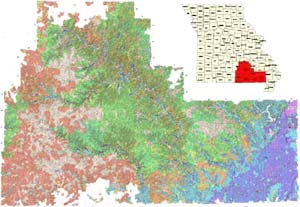

«Missouri River • Great Plains • Rocky Mountains» | «Radio • Ride • Resources»
Jim Harlan heads the Historic Vegetation Project, of the University of Missouri- Columbia, Department of Geography. He and a team of grad students are converting the General Land Office 1815 survey notes into geographic data. He now has maps of the Missouri River of Lewis & Clark's time, quite different from the river of today. We interviewed him June 2001.
Who are these guys from 1815, what are they doing out there?
They're surveying for the General Land Office for the United States. They hired a corps of surveyors. They'd walk these lines, describe what they saw, and make a value-assessment: first rate, second rate, third rate, primarily for farming or timber. And they would rate the timber: good, bad, thin, sparse. They'd give a description of the other vegetation, the under-story. They'd say they were in barrens -- the old term barrens, being an opening in the forest -- or open beautiful prairie. So we get the divisions between forest, woodland, open woodland, barrens, and where the prairie was.
They also told us exactly where the creeks were, the old name of the creek, the depth of the water, the width of the water and how fast it was running. So I'm getting all the landscape from this. Now, I can take all that in conjunction with the Lewis & Clark notes -- because they gave distances point to point, where they were at and what they saw. I could start Lewis & Clark out over at Wood River, and read their notes, and the river course and the islands that I'm getting from the survey correlates 99% with what Lewis & Clark said. It locks in.
Without that old river and survey notes, we'd have no living idea of where Lewis & Clark were; you'd be way off, you wouldn't know what they were talking about, because they could easily have been five miles away, if you were using the present river.
Today's river is fourteen foot deep, and a half mile wide. Well, that river back then was a mile or two miles wide, and four foot deep, full of sand, cottonwood trees and islands. That keelboat, I believe I read it was necessary for them to have about four feet of draft, well, that's the reason they wound up dragging that thing to Montana, because they had a hell of a time trying to find deep enough water where they could sail openly. Plus the sand was shifting back and forth on them all the time, they had all sorts of problems, breaking the mast, the boat getting caught in eddies and sand, and turning around on them. I can look at that old river, and see why they had problems in there.
river is fourteen foot deep, and a half mile wide. Well, that river back then was a mile or two miles wide, and four foot deep, full of sand, cottonwood trees and islands. That keelboat, I believe I read it was necessary for them to have about four feet of draft, well, that's the reason they wound up dragging that thing to Montana, because they had a hell of a time trying to find deep enough water where they could sail openly. Plus the sand was shifting back and forth on them all the time, they had all sorts of problems, breaking the mast, the boat getting caught in eddies and sand, and turning around on them. I can look at that old river, and see why they had problems in there.
Why were these survey guys out there?
The Jefferson dream. To move the yeoman farmer onto the land. They were surveying the land in an organized manner so that somebody could tell where somebody else's property was. They were getting it ready for sale. That's the reason they were here.
Do you have any opinions about land and river use?
No. I'm a geographer. The importance of studying the earth is as the home of mankind. We've always had this push to change things and make it more like we want it, or make it more like what we perceive home to be. Basically, that's what people do. Indians did the same thing. They liked to burn the place. They had horses, and the horses have to eat grass. So in order to maintain a grassland they had to burn it all the time.
When whites came in, miraculously, you had stuff like Post Oak, Blackjack Oak taking it over again. A lot of those forests at St. Louis and St. Charles on the river right now weren't there at all. It was prairie.
If you look at present land covering where the prairies were, it's cropland. That's what they plowed up, mostly, was the prairies, they went right after that prairie with those plows.
![]() Maps- Historic Vegetation Project
Maps- Historic Vegetation Project
![]() Article- "On History's Trail," Columbia Daily Tribune
Article- "On History's Trail," Columbia Daily Tribune
![]() Bio- James Harlan, University of Missouri- Geography
Bio- James Harlan, University of Missouri- Geography
«Missouri River • Great Plains • Rocky Mountains» | «Radio • Ride • Resources»
©2001 Barrett Golding / Josef Verbanac
![]() Funding from the Corporation for Public Broadcasting
Funding from the Corporation for Public Broadcasting